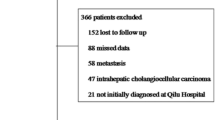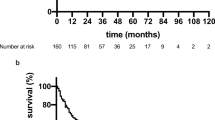Abstract
Purpose
We aimed to emphasize the prognostic impact of differences included in the 8th versus the previous 7th edition of AJCC (American Joint Committee on Cancer) Cancer Staging manual for hepatocellular carcinoma (HCC).
Methods
A number of 87 consecutive HCCs were retrospectively evaluated and staged, using the 7th and 8th edition of AJCC staging systems. The clinicopathological parameters were correlated with the overall survival rate. No preoperative chemotherapy was received by any of the patients.
Results
According to the 7th edition of AJCC manual, 52 of the 87 cases were staged as pT2 and 35 as pT1. After restaging, according to the 8th edition, 23 of the 52 pT2 cases were understaged as pT1b, and the rest of the 29 remained as pT2. Regarding the 35 HCCs classified as pT1, using 7th edition, all of them were restaged as pT1a. Compared to the 7th staging system, using the 8th edition of AJCC manual, the percentage of pT2 tumors significantly decreased, from 59.77 to 33.33%. The patient’s gender, age, tumor focality, and grade of differentiation did not prove to have any prognostic value. Regarding pT stage, it does not influence the overall survival rate, independently from the used staging system.
Conclusion
The staging criteria, in the most recent edition of AJCC, are simplified and allowed tumor understaging. These changes do not have independent prognostic value. The prognostic impact of pT understaging should be evaluated in larger cohorts.




Similar content being viewed by others
Availability of Data and Materials
The used data were stored in a database but are confidential data, based on our institutional rules.
References
Rastogi A. Changing role of histopathology in the diagnosis and management of hepatocellular carcinoma. World J Gastroenterol. 2018;24:4000–13.
Turdean S, Gurzu S, Turcu M, Voidazan S, Sin A. Current data in clinicopathological characteristics of primary hepatic tumors. Romanian J Morphol Embryol. 2012;53:719–24.
Ferlay J, Soerjomataram I, Ervik M, Dikshit R, Eser S, Mathers C, et al. GLOBOCAN 2012 v1.0, Cancer Incidence and Mortality Worldwide: IARC CancerBase No. 11 [Internet]. Lyon, France: International Agency for Research on Cancer; 2013. Available from: http://globocan.iarc.fr. Accessed on 22/03/2019
Wan S, Nie Y, Zhu X. Development of a prognostic scoring model for predicting the survival of elderly patients with hepatocellular carcinoma. Peer J. 2020. https://doi.org/10.7717/peerj.8497.
Pittman M, Brunt E. Anatomic pathology of hepatocellular carcinoma: histopathology using classic and new diagnostic tools. Clin Liver Dis. 2015;19:239–59.
Hobeika C, Cauchy F, Sartoris R, Beaufrere A, Yoh T, Vilgrain V, et al. Relevance of liver surface nodularity for preoperative risk assessment in patients with resectable hepatocellular carcinoma. Br J Surg. 2020. https://doi.org/10.1002/bjs.11511.
Bara T Jr, Jung I, Sugimura H, Bara T, Beleaua MA, Gurzu S. A systematic review of the possible carcinogenic role of the aristolochic acid. Romanian J Morphol Embryol. 2017;58:41–4.
Saleh D, Muhammad M. Current and future treatment of hepatocellular carcinoma: an updated comprehensive review. J Clin Transl Hepatol. 2018;6:69–78.
Edge S, Byrd D, Compton C, Fritz A, Greene F, Trotti A. AJCC Cancer staging manual, vol. 18. 7th ed. Chicago: Springer International Publishing: American Joint Commission on Cancer; 2009. p. 191–200.
Amin MB, Edge S, Greene F, Byrd DR, Brookland RK, Washington MK, et al. AJCC Cancer staging manual, vol. 22. 8th ed. Chicago: Springer International Publishing: American Joint Commission on Cancer; 2017. p. 287–93.
Liu P, Xie S, Hu S, Cheng X, Gao T, Zhang C, et al. Age specific sex difference in the incidence of hepatocellular carcinoma in the United States. Oncotarget. 2017;8:68131–7.
Omata M, Cheng A, Kokudo N, Kudo M, Lee J. Asia–Pacific clinical practice guidelines on the management of hepatocellular carcinoma: a 2017 update. Hepatol Int. 2017;11:317–70.
Guo W, Zhao S, Yang Y, Shao G. Histological grade of hepatocellular carcinoma predicted by quantitative diffusion-weighted imaging. Int J Clin Exp Med. 2015;8:4164–9.
Martins-Filho SN, Paiva C, Azevedo RS, Alves VAF. Histological grading of hepatocellular carcinoma-a systematic review of literature. Front Med. 2017;4:193.
Kee K, Wang J, Lin C, Wang C, Cheng Y, Lu S. Validation of the 7th edition TNM staging system for hepatocellular carcinoma: an analysis of 8,828 patients in a single medical center. Dig Dis Sci. 2013;58:2721–8.
Santambrogio R, Salceda J, Costa M. External validation of a simplified BCLC staging system for early hepatocellular carcinoma. Eur J Surg Oncol. 2013;39:850–7.
Huang XT, Chen LH, Huang CS, Li JH, Cai JP, Chen W, et al. Establishment of a nomogram by integrating molecular markers and tumor-node-metastasis staging system for predicting the prognosis of hepatocellular carcinoma. Dig Surg. 2019;36:426–32.
Minagawa M, Ikai I, Matsuyama Y, Yamaoka Y, Makuuchi M. Staging of hepatocellular carcinoma: assessment of the Japanese TNM and AJCC/UICC TNM systems in a cohort of 13,772 patients in Japan. Ann Surg. 2007;245:909–22.
Fodor D, Jung I, Turdean S, Satala C, Gurzu S. Angiogenesis of hepatocellular carcinoma: an immunohistochemistry study. World J Hepatol. 2019;11:294–304.
Gurzu S, Kobori L, Fodor D, Jung I. Epithelial mesenchymal and endothelial mesenchymal transitions in hepatocellular carcinoma: a review. Biomed Res Int. 2019;2962580. https://doi.org/10.1155/2019/2962580.
Chun YH, Kim SU, Park JY, Kim DY, Han KH, Chon CY, et al. Prognostic value of the 7th edition of the AJCC staging system as a clinical staging system in patients with hepatocellular carcinoma. Eur J Cancer. 2011;47:2568–75.
Kamarajah SK, Frankel TL, Sonnenday C, Cho CS, Nathan H. Critical evaluation of the American Joint Commission on Cancer (AJCC) 8th edition staging system for patients with hepatocellular carcinoma (HCC): a surveillance, epidemiology, end results (SEER) analysis. J Surg Oncol. 2018;117:644–50.
Kim IG, Hu XG, Wang HJ, Kim BW, Hong SY, Shen XY. The 7th/8th American Joint Committee on Cancer and the modified Union for International Cancer Control staging system for hepatocellular carcinoma. Yonsei Med J. 2019;60:140–7.
Sun YY, Soon HU, Chung GS, Yoo JL, Tae HK, Yeon SS, et al. Validation of American Joint Committee on Cancer 8th staging system in patients with resected hepatocellular carcinoma. Gut Liver. 2019;13:103.
Ueno M, Morizane C, Ikeda M, Okusaka T, Ishii H, Furuse J. A review of changes to and clinical implications of the eight TNM classification of hepatobiliary and pancreatic cancers. Jpn J Clin Oncol. 2019;49:1073–82.
Funding
This study was funded by Romanian National Authority for Scientific Research, CNCS – UEFISCDI, project number 20 PCCF/2018, code: PN-III-P4-ID-PCCF-2016-0006. The financial resources were used for data interpretation only.
Author information
Authors and Affiliations
Contributions
SC wrote the manuscript and collected data about Romanian patients, JI performed interpretation of histopathological data, KL supervised collection of data regarding Hungarian patients and performed liver transplantation; KZ performed statistical assessment; SR contributed to data collection and literature review; FD collected clinical data about Hungarian patients; SG supervised the study design and allowed final variant of the manuscript.
Corresponding author
Ethics declarations
Conflict of Interest
The authors declare that they have no conflict of interest.
Ethical approval
For the evaluation of the cases, the approval of Ethical Committee of University of Medicine and Pharmacy of Targu-Mures, Romania, and Semmelweis University, Budapest, Hungary, was obtained. As retrospective evaluation was done, signed informed consent of patients was not necessary.
Additional information
Publisher’s Note
Springer Nature remains neutral with regard to jurisdictional claims in published maps and institutional affiliations.
Rights and permissions
About this article
Cite this article
Satala, C.B., Jung, I., Kobori, L. et al. Benefits of the 8th American Joint Committee on Cancer System for Hepatocellular Carcinoma Staging. J Gastrointest Canc 52, 243–248 (2021). https://doi.org/10.1007/s12029-020-00394-z
Published:
Issue Date:
DOI: https://doi.org/10.1007/s12029-020-00394-z




